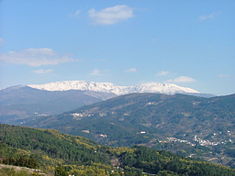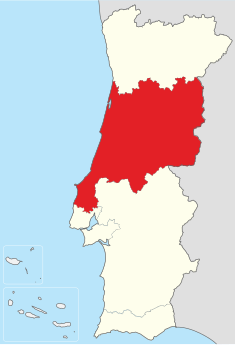Centro Region, Portugal
| Centro | |
| Região Centro | |
| Region | |
|
Symbolic of the Central Region, the Serra da Estrela the highest peak/mountain range in continental Portugal
|
|
| Name origin: centro, Portuguese for centre | |
| Country | |
|---|---|
| Region | Centro |
| Capital | Coimbra |
| - elevation | 119 m (390 ft) |
| - coordinates | 40°12′28″N 8°25′34″W / 40.20778°N 8.42611°WCoordinates: 40°12′28″N 8°25′34″W / 40.20778°N 8.42611°W |
| Lowest point | Sea level |
| - location | Atlantic Ocean |
| Area | 28,462 km2 (10,989 sq mi) |
| Population | 2,327,026 (2011) |
| Density | 81.76/km2 (212/sq mi) |
| Timezone | WET (UTC+0) |
| - summer (DST) | WEST (UTC+1) |
| ISO | PT |
| NUTS | PT16 |
| GDP (PPP) | 2013 estimate |
| - Total | € 40.754 billion |
| - Per capita | € 17,800 |
| GDP (nominal) | 2013 estimate |
| - Total | € 31.780 billion |
| - Per capita | € 13,900 |
|
Location of the Centro Region in context of the national borders
|
|
| Website: https://www.ccdrc.pt/ | |
| Statistics from INE (2005); geographic detail from Instituto Geográfico Português (2010) | |
The Centro Region (Portuguese: Região Centro, IPA: [ʁɨʒiˈɐ̃w ˈsẽtɾu]) is a region in central Portugal, and its capital is Coimbra. Other local cities with major administrative status inside this region are Aveiro, Viseu, Leiria, Castelo Branco, Covilhã, Figueira da Foz and Guarda. It is one of seven Regions of Portugal (NUTS II subdivisions). This is one of the regions of Europe, considered by the European Union for statistical and geographical purposes. Its population in 2011 totalled 2,327,026 inhabitants, and its area is 28,462 km² (density of 82 inhabitants per square kilometre).
Inhabited by the Lusitanians, an Indo-European people living in the western Iberian Peninsula, the Romans settled in the region and colonized it as a part of the Roman Province of Lusitânia. The Roman town of Conímbriga, near Coimbra, is among the most noted and well-preserved remains of that period. After the fall of the Western Roman Empire, Visigoths were the main rulers and colonizers from the 5th to the 8th century.
...
Wikipedia


